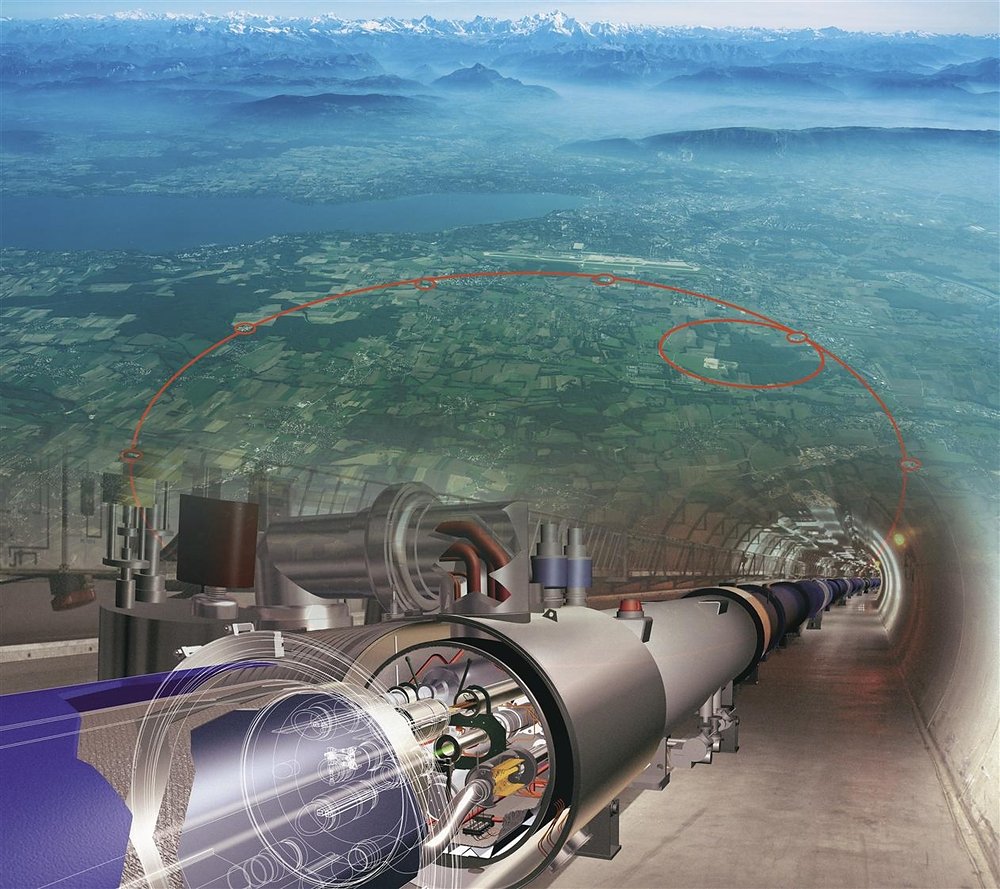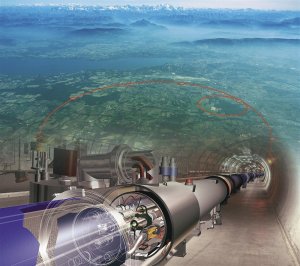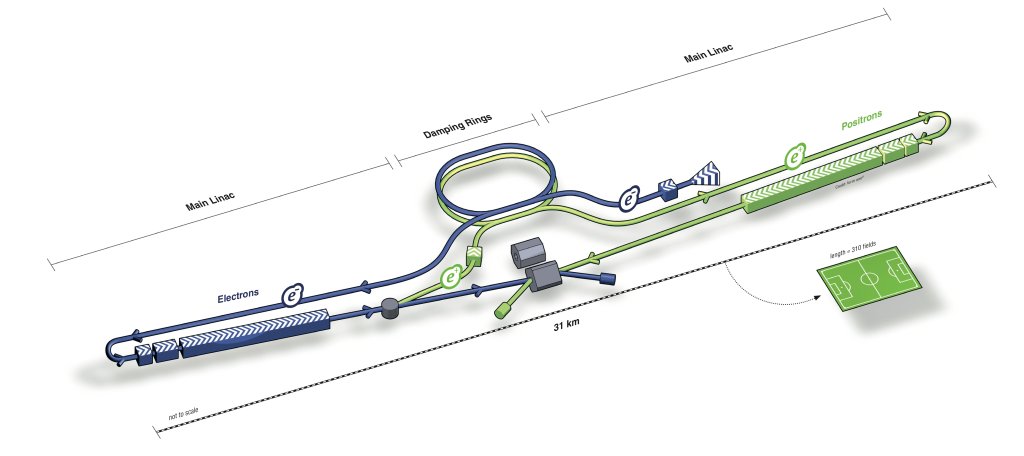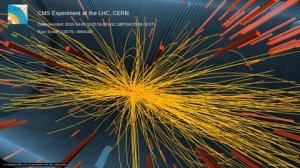

One of the greatest accomplishments of modern science is the invention of the particle accelerator. These massive machines have allowed scientists to study the fundamental laws that govern matter and they’ve given us a glimpse into the nature of the universe only a trillionth of a second after the big bang. Particle accelerators have been responsible for confirming, validating, supporting, refuting, and debunking a very large number of theories and hypothesis in specific regards to the standard model of particle physics – a unifying theory combining the strong force, weak force, and electromagnetic force that governs the world of the very small. The accomplishments of particle accelerators are just as exciting as how these behemoths actually work.
The Basic Idea and the Goal of Particle Acceleration:
Particle accelerators work on the same basic principles. They accelerate particles to very high speeds and then smash them together (I’ll note that there are particle accelerates that function at much lower energies found in everyday items, an example being cathode ray tubes that can be found in old-style televisions, but for the purposes of this article, those types of accelerators are irrelevant). Especially when we are trying to analyze things we can’t see with the human senses (thought, that might be changing) scientists rely heavily on our theoretical models to describe nature. The hallmark of any good scientific theory is predictiveness; as in, the theory predicts certain things will behave in a certain way. The only way to determine if the theory’s predictive abilities are right or wrong is to test them.

This is where particle accelerators come in. One of the first experiments performed in particle physics with accelerators helped us uncover the fundamental construction of atoms, including the electron orbital cloud, the empty space that exists between the atomic nucleus, which was also determined to be positive and well defined. All of that was achieved in the Rutherford Experiment in which Ernest Rutherford used alpha particles in a particle accelerator, fired them at gold foil, and analyzed radium emissions.
Using this general idea, smashing particles into other particles/substances, scientists are able to check their mathematical models against data they collect to see if the model is accurate, if it needs to be improved, or if it’s just wrong. The higher energies they use, the more research they can do.
How Accelerators Work: The Basics:
For an accelerator to work, it requires a few basic things.

Photo courtesy SLAC
- A particle source: the types of particles you want to generate governs what type of source you need. Some examples are electrons, which are generated by hot/cold cathodes, photocathodes, or radio frequency ion sources, and photons, which are generated from ion sources.
- A way to accelerate the particle, using one of two accelerator designs centered around electric fields as the “method of choice” for accelerating particles.
- A vacuum chamber through which particles will travel through.
- A target: because just accelerating particles isn’t good enough. The particles need something to hit.
- Various detectors to analyze what happens when your particles hit the target.
The First Smashers – Linear Accelerators

Building a particle accelerator is easy. You probably have everything you need laying in your garage. All you need are two parallel metal plates (with a hole drilled through them) and a battery that connects them. That’s literally it. This construction will generate an electric field that exists between the plates and this field will accelerate particles that pass through the plates. This type of accelerator is called a linear accelerator (linear for a line, because these accelerators are constructed in one long line) or linac for short.
The problem with using regular batteries is the accelerator is very weak. This places a limitation on the type of physics you can do. Bigger/more powerful batteries means more physics. The Stanford Linear Accelerator Laboratory (SLAC) is such a device.
Here, a narrow beam of particles are generated and shot, using electric waves created by klystrons, down a tube to their end destination some 3 kilometers (1.8 miles) away. This build is great for studying heavier ions because the ability to shoot them in a straight line allows the linac to get the ions to higher energies than those that can be accomplished in circular accelerators. The downside is these are very expensive and require a long straight path with which to function (and, you can’t achieve the same type of power you can in circular accelerators. SLAC operates at 50 GeVs whereas circular accelerators, like the Fermilab’s main ring, can operate at 400 GeVs (and higher).
Lords of the Rings – Circular Accelerators

Electrical fields cause a particle to travel in a straight line. In an effort to increase the power of the accelerators, and to peer deeper into the nature of matter and physics, scientists developed circular accelerators. Instead of having a single long tube powered by a continuous electrical field (which causes the particle to travel straight), scientists added magnets (which cause a particle to travel in a circular path). This allowed particle physicists to reuse a single electrical field by shooting particles in a circular path. When the peak acceleration is reached, they smash particles together and see what happens.
For those geeks squirming in their seats at my pluralizing of “rings,” these particle colliders use multiple rings (usually with particles traveling in opposite directions) to achieve their magic.
The most powerful particle colliders to date have been circular, none more powerful than the famous than CERN’s Large Hadron Collider (LHC), located near Geneva and spanning the Franco-Swiss border. The LHC has been responsible for uncovering some of the deepest mysteries of the universe, such as discovering the Higgs boson and peeling back the curtain on the conditions that existed in the very early universe. The LHC is currently offline, undergoing repairs and upgrades that should increase its scientific value.
Interestingly enough, in the works is an accelerator known as the International Linear Collider (ILC), which will make the LHC look like a child’s plaything. As the name suggests, the ILC is a linac and it will be tasked with taking over where the LHC left off by probing the nature of extra dimensions (should they exist), supersymmetry, and the nature of dark matter.

The View from Inside the Particle Collider
If you were inside the particle collider in action, what would you expect to see? Well, if you stuck your head into a particle collider, you’d probably end up like Anatoli Bugorski who suffered from a particle collider accident where his head managed to get inserted into the particle stream. Fortunately, he survived, but you probably don’t want to try this at home.
But, lets assume you were observing and unable to interact with the beam. Using you’re human senses, you wouldn’t see much of anything (as far as I’m aware). The event would be completely invisible to you.

Image Credit and copyright: CERN
If you were the size of a particle and able to see the entire electromagnetic spectrum, you would have a spectacular show. You would see two opposing swarm of particles flying towards each other in an organized-chaos likened to the big final space-battle in a Hollywood blockbuster. The particles would inch closer to each other bent on their suicide death run. Suddenly, particles would begin to collide and you would see flashes of light as the very structures of matter are viciously torn apart revealing their inner building blocks. Fermions, quarks, leptons, bosons, and their composites burst from the wreckage of successful collisions, emitting all sorts of radiation (photons) in the process. These basic building blocks fly in all directions in one last final shotgun-like volley impacting the walls of the collider, which is lined with sensors. Everything would then go dark again as you awaited the next epic battle while scientists busily looked over their results and prepared for the next test.